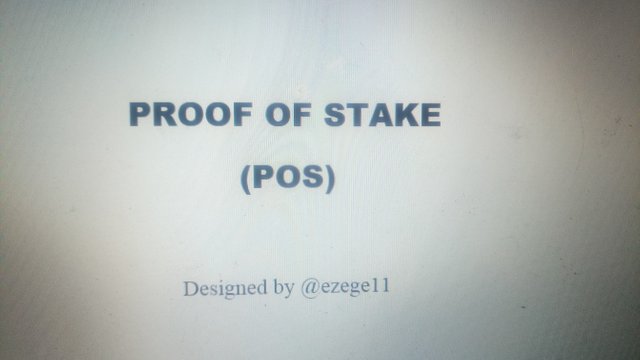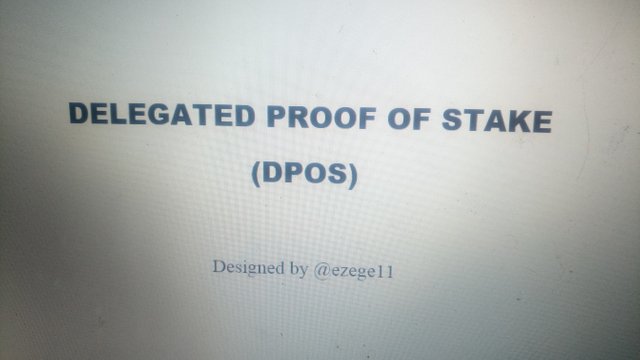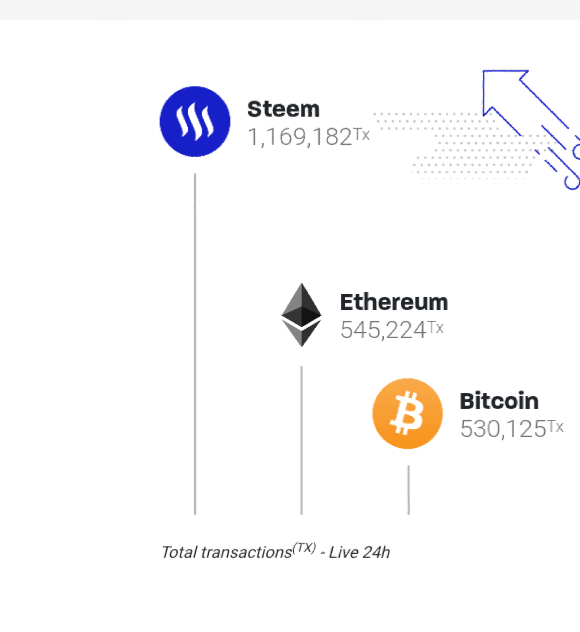Crypto Academy Season 4 Beginners' Course - task 6: different types of Consensus Mechanism || By @ezege11

Good day prof. @sapwood, it is a privilege to learn from you once more, and in fulfilment of the teaching, below is my assignment.

Home work
- What is the difference between PoS and DPoS? Advantages and disadvantages? Name a few block chain projects which uses the DPoS concensus mechanism and indicate the scaling capacity?

Introduction
In the crypto ecosystem the importance of blockchain cannot be over emphasized. Blockchain being a decentralized system, it is capable of compiling data of transactions of users in the blockchain waving aside the need of a middle man through peer to peer process.
Blockchain can be said to be series of information containing blocks linked to a particular server.
Blockchain is void of a central authority or control thereby making it corruption free.
- Decision making in block chain : how are decision made?
- How does things get done on blockchain?
We all know that in a centralized system, decisions are made by the leader or the leading group. But in blockchain there is no leader, i.e no pivot authority controls the affairs of blockchain.
So, how are decisions made? How are the aims of blockchain achieved?
Unlike the centralized system where decisions are made by the leading party, decisions in blockchain are made by the consensus reached by everyone on the blockchain.
Consensus being an important feature of blockchain, gives the people authority to determine if a transaction is valid or not.
The " consensus mechanism" is the means/protocol whereby people on the blockchain achieve consensus.
What is consensus mechanism?
Consensus mechanism is a method consensus decision-making is achieved.
Consensus mechanism with respect to blockchain, is a protocol that gives users authority to contribute to the blockchain. It allows users to agree on a particular thing before being executed.
It is used by the blockchain to insure trust, security and agreement.
The first ever consensus algorithm in the history of blockchain is the proof-of-work (PoW) consensus mechanism.
Different blockchain utilizes different types of consensus mechanism, which includes; proof-of-work (PoW), proof-of-stake (PoS), delegated proof-of-stake (DPoS), proof-of-capacity (PoC), Byzantine Fault Tolerance (BFT)/ Prectical Byzantine fault tolerance (PBFT), proof of burn (PoB), proof of Elapsed time (PoET) proof of authority (PoA), proof of activity, proof of importance (PoI) direct acyclic graphs (DAGs), etc

The Proof-of-stake (PoS)

PoS in the year 2011 was proposed as an alternative to proof-of-work (PoW). PoS and PoW shared the same goal for reaching consensus but with a total different means.
Miners are eliminated in the PoS consensus, it is void of specialised hardware (nodes), and there is a reduction in high energy consumption.
In PoS system you stake unlike in PoW where miners put in hardware and electricity.
Staking on PoS system is placed by the individual and at a particular interval, the system then selects a node randomly which validates the next transaction or block. The selection is determined by amount of stakes, staking age, and randomization.
The staked amount determines the che chance of being selected for the next block.
Factors that determine selection in PoS as validator
- Amount of stake: you have a greater chance of being selected of you stake high. i.e higher stake higher chance of being selected.
Randomization: validators are selected randomly by the highest stake and the lowest hash value.
Age of coin: nodes are chosen based on their period of stake. i.e how long they have staked their token.
Nodes on selection for validation of the next transaction, signs the block and add it to the blockchain. The node is rewarded with the transaction fees associated with the block it mined after a successful a validation.
Miners are rewarded with funds from transaction fees in PoS while in PoW miners are given new token as appreciation.

Advantages of PoS
Eco-friendly: it is affordable and user friendly unlike PoW where miners are required to have a computer hardware that consumes a lot of electrical energy.
Highly secured: PoS prevent fraudulent activities because of the possiblities of a node loosing his stake once fraud is allowed.
The network is more decentralized due to randomization process of selecting validators and overwriting the essential needs of mining pool.
Forging of blocks helps reduce the amount of energy consumed in PoS.
Delegated Proof-of-stake ( DPoS)

Delegated proof-of-stake was developed to establish a technology based democracy which was done through an election process to stop centralization and fraudulent use of the blockchain.
Daniel Larimer, and American software developer and founder of EOSIO software, steemit, and Bitshares, developed DPoS in the year 2014.
DPoS was built as a replacement for both PoW and PoS because it is more scalable than traditional algorithm.
DPoS was designed to eliminate the need to use high energy demanding machines and time consumption.
The first DPoS based blockchain developed is Bitshares.
How DPoS works
It is usually collocated through election process. The general masses on the blockchain vote for some swayful users in the blockchain for the role of "witnesses".
Witnesses are responsible for creation or addition of block to the blockchain. For instance on steemit, there are 21 witnesses governing the affairs of the blockchain. The witnesses are in charge of transactions validation.
Administrators of the blockchain are known as delegates. The general masses in the blockchain elects them to govern the affairs of the blockchain and propose vital changes.
- The work of delegates includes:
- To ascertain transaction fee for the blockchain
- To ascertain block size of the blockchain
- To determine block interval of the blockchain
- To determine witness pay.
Election on blockchain is a continuous process for that reason, witnesses won't involve themselves in malicious activities on the blockchain so as not to loose their position to another competitor.
DPoS os the most democratic approach to blockchain consensus mechanism in that it granted everyone on the blockchain equal opportunity to be elected as a witness.
Advantages
- It helps in carrying everybody along including small holders.
- It is decentralized and at such practices true democracy.
- It is users friendly and have minimal need for electric energy.
- Because of the democratic system, the general masses selects who is best for them as a witness.
- Minimum transaction fees.
- Because of the penalty of loosing ones position as a witness, witnesses are subjected to being honest.
Disadvantages
- Limited number of witnesses. For instance, in tron blockchain there are only 27 super reps and 21 witnesses on steemit blockchain.
- It looks like a centralized system because of the presence of delegates, witnesses and reps , where whales are granted more control of the network their friends as witnesses.
- There are tendencies of low vote turnout.
- It works well for social networks such as steemit because of its semi-decentralized nature.

Differnces between PoS and DPoS
| Pos | Dpos |
|---|---|
| (1) Block creator is selected evolutionally | Block creator is been voted in by the masses. |
| (2) Less scalable | more scalable |
| (3) Miners are rewarded with funds from transaction fee | valid members are appreciated with staking rewards. |
| (4) Selection is partial in the sense that only those with low hash and high stakes are selected | everyone have equal opportunity to be elected as validator or a delegate. |
| (5) Best for financial use cases | best for social use cases |
| (6) presence of transaction fee | Viod of transaction fee |
| (7) Consensus is determined randomly | consensus is based on trust of the delegates |
Name a few blockchain projects which use DPoS consensus mechanism and indicate the scaling capacity.
Scalability of a blockchain is its ability to enlarge its capacity to process more transactions per sec. It can also be seen as the transaction speed i.e the amount of transaction processed in a given second.
Listed below are some blockchain that uses the DPoS consensus mechanism and their scaling capacities.
Steem
Steem is one of the tokens authors reciev for sharing ideas on steemit. It is a social media blockchain whose scaling capacity is rated higher than that of ethereum and bitcoin network. The infogragh above shows that steem is better than both bitcoin and ethereum networks.
EOS
EOS blockchain was built for public as well as private use cases.
It is void of on-chain transaction costs.
Daniel Larimer, the founder of steemit is a co-founder of EOS and it has a scalability of 10,000 transactions per second (TPS). EOS can handle more transactions from separate blockchains due to its inter-blockchain transfer feature.
Bitshares
.png)
Bitshares have a scalability of 100,000.
Tron
.png)
Tron was founded by a Chinese software developer named Justin Sun. Tron is integrated in steemit blockchain network after an agreement was reached on december 2020 that is the reason why steemit users are rewarded with Tron for posting on steemit platform. Tron have a scalability of over 1,000 transactions per sec.
Telos
.jpeg)
Telos is the second most utilized blockchain having a scalability of 10, 000 TPS and 0.5 seconds block time. The native utility token of telos blockchain is TLOS.

Source
Nano was developed by Colin LeMaheiu in the year 2015 as the world fastest blockchain having no transaction fees. The network is capable of processing over 1, 000 transactions per second.
Worbi
Worbli is a blockchain built to facilitate business as well as individuals. It has a scalability of 4, 000 TPS.
Conclusion
Agreement, trust and security is brought about by the use of consensus mechanism in blockchain networks. It is a united way of reaching agreement over transactions and other affairs of blockchains.
DPoS is like PoS though not entirely decentralized takes a different approach.
In this system, stakers choose delegates that validates the blocks, and transactions.
The minimal number of delegates makes DPoS exceptional and is used by EOS, Steemit, and others.
Among blockchains that uses DPoS, scalability is better as compared to those that does not operate on the DPoS algorithm.

Special thanks to the professors;
@sapwood
@awesononso
@reminiscence01
I appreciate my readers for their time.


.jpeg)